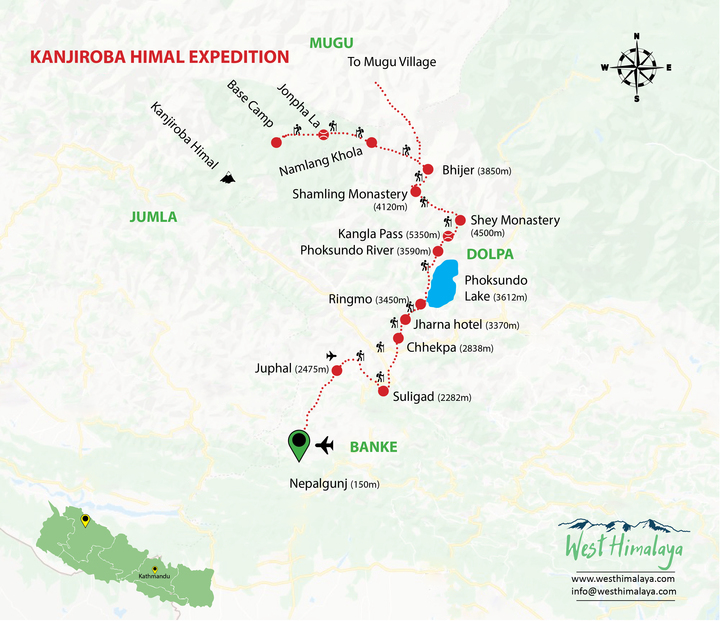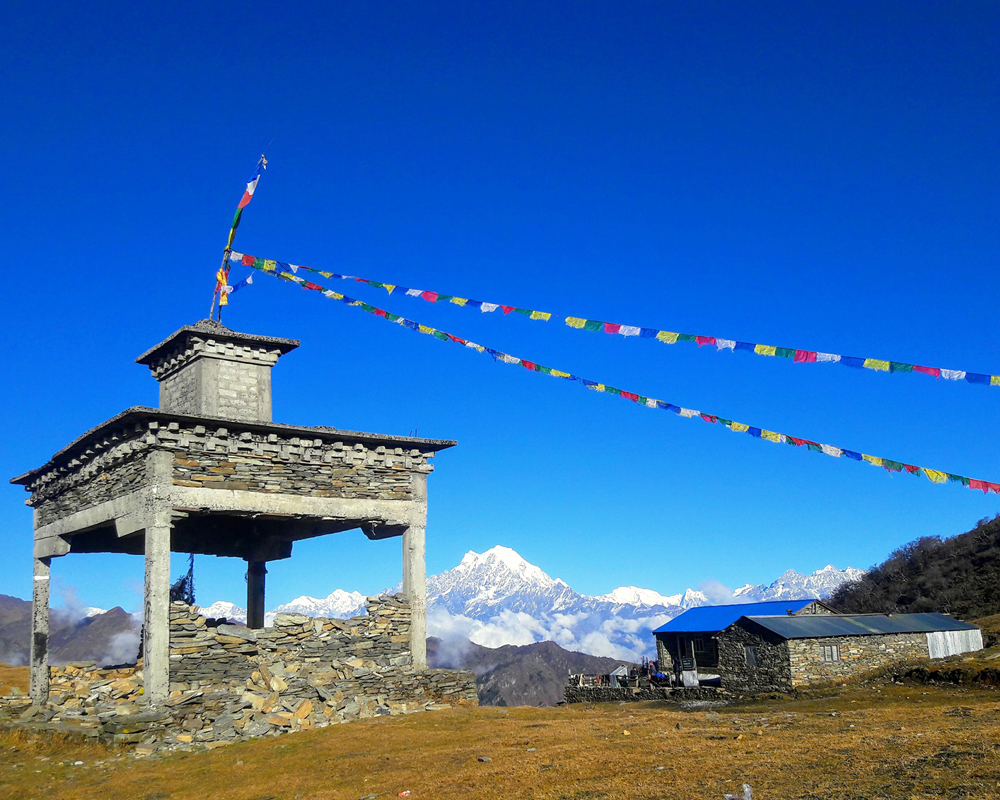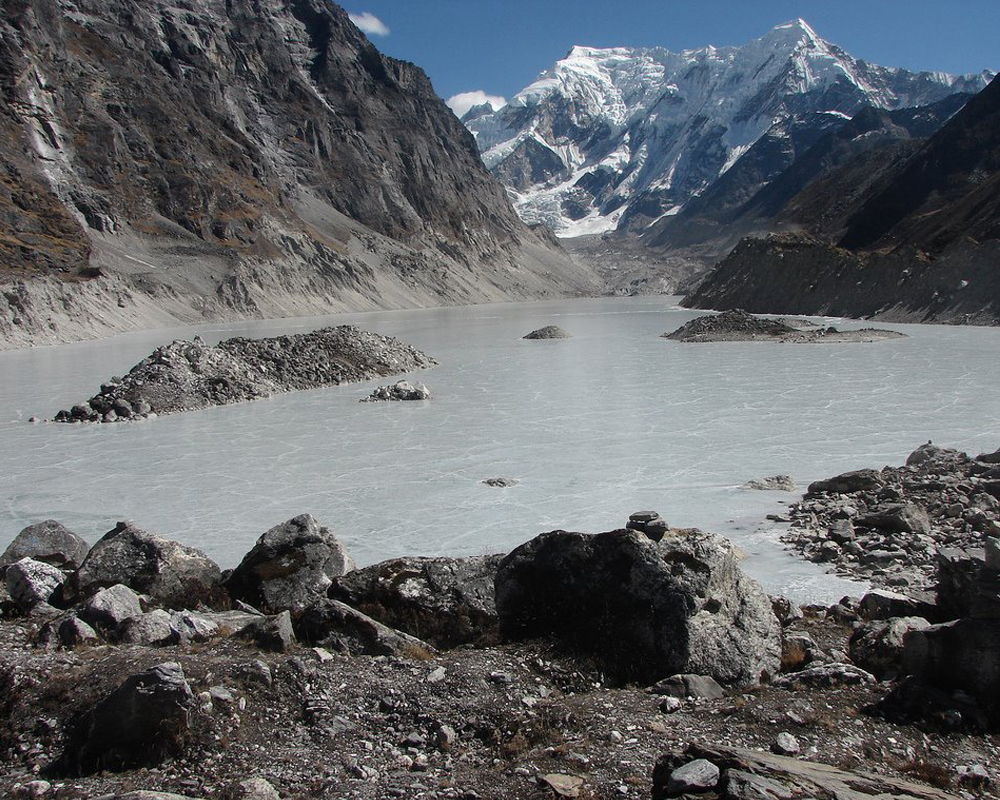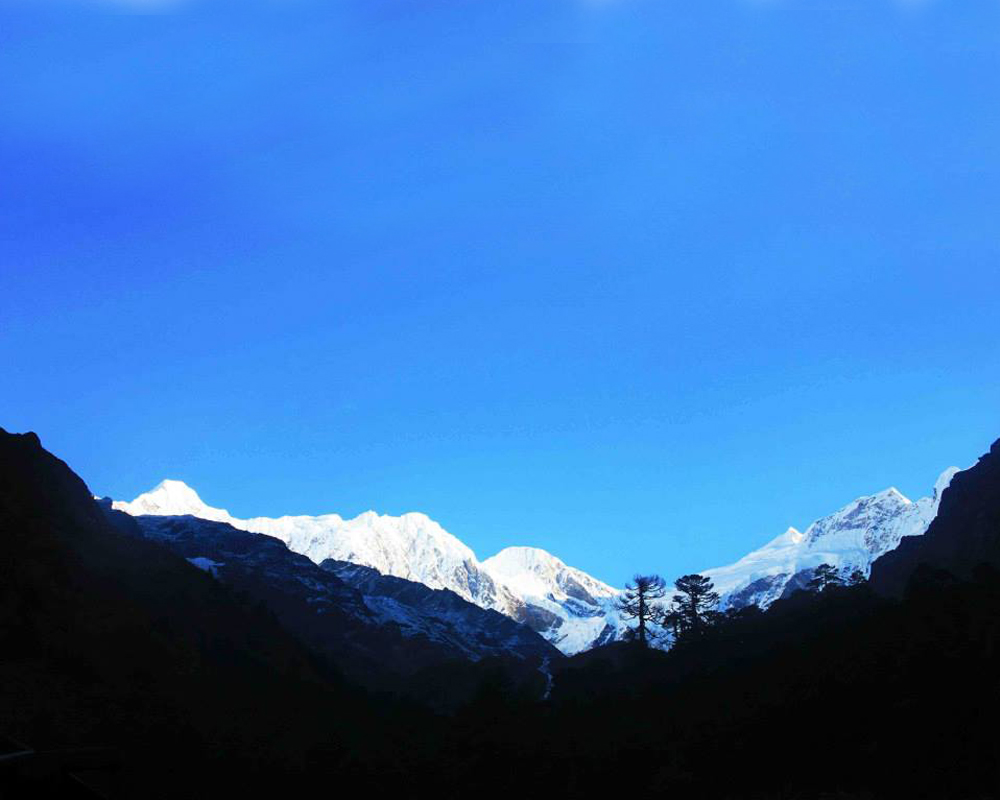- Climbing
- Kanjiroba
Kanjiroba Himal

Trip Highlights
-
Guided expedition to the summit of Kanjiroba
-
Full-service camping trek to the hidden Upper Dolpo
-
High mountain passes, hidden valleys and alpine meadows
-
Ancient Buddhist and Bon monasteries
-
A peek into the unique culture and tradition of the Bhotiya people
-
The turquoise blue Phoksundo Lake
-
A trek into the wilderness

Overview
Trip Itinerary
Arrival Kathmandu (1360m)
Welcome to Nepal. After completing immigration formalities, you will find our representatives outside the arrival lounge. You will be accorded traditional Nepali welcome by offering garland or khadas. Our representative will transfer you to your hotel. Rest of the day is free for independent activities. In the evening, meet your guide and attend trek briefing session at your hotel.
O/N: HotelSightseeing of Kathmandu Valley
Today, you will be taken for a sightseeing of different attractions in Kathmandu Valley while we look after your permits and other technicalities. Begin your day with a sightseeing trip to Swoyambhunath Temple. Popular among tourists as Monkey Temple, thanks to abundance of Rhesus macaque monkeys, the main attraction here is the magnificent white stupa topped by a golden spire. The stupa is believed to be as old as the Kathmandu Valley, hence it has been designated as UNESCO World Heritage site. Then, we move on to Kathmandu Durbar Square – a palace complex of Malla kings -- which dates back to 16th century. The area is a repository of ancient wooden, metal and stone crafts. After lunch, move on to Pashupatinath Temple – the largest temple complex in Nepal. The main attraction here is the pagoda temple dedicated to Lord Shiva. The present temple is believed to have been built in the 5th century. However, the main shrine is believed to have existed since as early as 400 BC. There is an open air crematorium on the banks of Bagmati River near the temple complex. You can observe last rites performed on the dead body as per Hindu tradition before it is consigned to flames.
Then you will be transferred back to your hotel.
Fly to Nepalgunj (150m)
After breakfast, our guide will escort you to the Kathmandu airport for your flight to Nepalgunj. Nepalgunj is the commercial hub of the mid and far western Nepal. The flight takes about an hour. Upon arrival at Nepalgunj, check into your hotel. It’s a free day for you as flights to the airstrips in the Himalayas are possible only in the morning. In the evening, you can take a stroll in downtown Nepalgunj or visit Bageshwari temple – a major attraction in this Tarai town which is located near Nepal’s border with India.
O/N: HotelFly to Juphal (2475m) and trek to Dunai (2,000m) – Approx 35 mins flight, 3 hrs trek
Juphal is the airstrip in Dolpa district. The flight takes about 35 minutes. The flight provides you with the opportunity to enjoy bird’s eye view of Himalayas, terraced land, forests and beautiful settlements. It is unofficially the gateway to the Dolpo Region as Dolpa district is yet to be connected to the road network. Juphal is a small mountain village with some shops and lodges. Meet your support staff here and start walking toward Dunai. From Juphal, the trail climbs south east above the Thulo Bheri valley. The trail then passes through the beautiful terraced fields to Kalagauda village. From here, follow the southern bank of Bheri River to Dunai – the district headquarters of Dolpa. It’s a bustling marketplace seated on the banks of Bheri River.
O/N: TentTrek to Chhepka (2838m) - 6 hrs Walk
Continue walking after having breakfast at your camp. Descend through the streets of Dunai and cross the Bheri River. Then, walk on the northern bank of the river toward Suligad. After a short walk, you will come across the check post of Shey Phoksundo National Park. Show your permits here. Then continue walking upstream of Suligad River. Suligad River drains Phoksundo Lake. The trail is on rocky surface and passes through hemp bushes to the settlement of Kageni. From there, the trail passes through maple and walnut forests. Continue walking toward Shyanta village. Fluttering player flags and chhortens hint that you are entering the Buddhist area. A final push of about one and half hours through a narrow trail will take you to Chhepka. Chhepka is a small settlement seated in the middle of millet and wheat field. Your camp will be set up near the village.
O/N: TentTrek to Jharana Waterfall (3370m) – Approx 5-6 hrs
Today, you will take to a beautiful place called Jharana. Jharana means waterfall in Nepali. As the name of the place suggests, you will be rewarded with a spectacular view of a beautiful 1080-feet waterfall. The trail passes through a forest of cedar trees and soon reaches winter settlement for people of Ringmo village. From here, the trail climbs to an open countryside to an elevation of 3,300 meters. You get breathtaking view of the waterfall and Phoksundo Lake in the horizon faraway. The waterfall drains the Phoksundo Lake.
O/N: TentTrek to Ringmo Village (3450m) – Approx 5-6 hrs
As usual, start early in the morning from your camp. You trek through birch forests upstream of the Phoksundo River. After a short walk, cross a bridge and follow the trail to the north toward Phoksundo Lake. A final push from here through the Phoksundo River channel will take you to a vast meadow of Ringmo. It is a grazing ground for cattle owned by the people of Ringmo. Ringmo is a beautiful settlement overlooking the Phoksundo Lake. Ringmo is one of the significant Bon villages in the Dolpo region. Bon used to be the religion of people living in the northern reaches of Nepal before the advent of Buddhism. Many scholars believe that Dolpa used to be the center of the ancient Bon kingdom known as Zhang. Your camp will be set up near this beautiful village. Tomorrow, you will trek to the lake.
O/N: TentTrek to Phoksundo Khola – Approx 4-5 hrs
Leave the Ringmo village early in the morning. The trail moves around the western end of the lake as it climbs on a rocky ledge. In some places, the trail sits vertically above the lake giving you the much-needed thrills. In some places, the unsteady trail is on suspended wooden planks supported by pegs nailed into rock crevasses. The trail is pictured in French filmmaker Eric Valli’s popular movie Himalaya. Once you reach the top, the path descends and opens up to a lush meadow into the flood plains ot Phoksundo Khola. After walking through the valley, cross the Phoksundo Khola river and reach your campsite on the riverbank.
O/N: TentTrek to Phoksundo Bhanjyang
Today, you will cross the first high pass of the trek. Start early after having breakfast at your camp. You will get to enjoy the views of Chamlang VI and VII peaks from the trail today. The trail will lead you through a glacier valley toward north. Cross Phoksundo Khola on a wooden bridge at a place where a small mountain stream joins it, wand walk toward north east. After a long climb, the trail opens up into a meadow where you can see sheep and mountain goats grazing. From here, the trail climbs further up to a ravine. A hard climb from here will take you to the top from where you will be able to see the Kang La Pass. Your camp will be set up near the pass.
O/N: TentPhoksundo Bhanjyang to Shey Gompa (4,500m) via Nangda La pass (5,360m) Approx -- 5-6 hours
We start early in the morning as strong winds later in the day will make it difficult for us to cross the pass. As the trail is full of loose rocks, walk slowly and follow your guide. The climb to the top of the pass is physically demanding. However, you will be rewarded with excellent views of valley divided by small rivulets below. After spending sometime at the pass, start descending. The trail to the valley floor is very steep. From the valley floor, the trail is leveled but crisscrossed by a river. The trail passes through beautiful meadows where you can see grazing yaks, sheep and mountain goats. Leave the meadows after crossing the river on a log bridge. A small climb will take you to the magnificent Shey Gompa where you will stay for the night.
O/N: TentRest day for acclimatization
Today, you will take the much-needed rest day for acclimatization. You can spend the day exploring the Shey Gompa which was built in 1965. The main attraction at this monastery is the giant statue of Shakyamuni Buddha in a seated posture. The copper statue has gold coating. You can catch breathtaking view of the Crystal Mountain from the monastery premises. The mountain is considered sacred by the local people and its cliffs are laced with quartz. After visiting the monastery, explore the Shey village. Like Ringmo, it is also a Bon village. Interact with locals and observe their culture, tradition and lifestyle.
O/N: TentTrek to Bhijer (4120m) – Approx 7 hrs
Today, you will trek to one of the ancient monasteries in the Dolpo Region i.e. Samling Monastery. Start from Shey Gompa early in the morning. The trail is on the eastern side of Tartan Khola and passes through a high grazing ground near Den La Pass. From here, the trail gradually drops to Tora. There are beautiful meadows in Tora which are used by locals af Bhijer as summer grazing ground for their yaks. After a short walk from the grazing ground, you will reach a place called Tora (4,500m). Samling Monastery lies further below. A short trek from here will take you to Bhijer.
O/N: TentTrek to Namlang Khola – Approx 5-6 hrs
Resuming walking after having breakfast at the camp. After a short walk, leave the main trail heading to Mugu and climb uphill toward Namlang Khola. The trail sees numerous ups and downs today until it falls to the banks of Namlang Khola where your camp will be set up.
O/N: TentTrek to Jonpala – Approx 5-6 hrs
You will gain lot of altitude today. Leave your camp on the banks of Namlang Khola early in the morning and start climbing an undulating trail passing through hills with sparse vegetation. You can see herds of Blue Sheep grazing along the trail or even the elusive snow leopard if you are lucky. Your camp will be set up at Jonpala.
O/N: TentTrek to Kanjiroba Base Camp – Approx 4 hrs
It’s a relatively shorter day. The trek is nice and short, but its uphill all the way to the base camp. You are advised to walk slowly yet steadily taking multiple breaks to restore the energy. Your camp will be setup at the base camp where you will spend many nights acclimatizing and honing your climbing skills before making the final assault on the mountain.
O/N: TentPreparations and Summit
Preparations and Summit
O/N: TentTrek back to Juphal using same route
From the base camp, you will use the same route to return to Juphal. At Juphal, a small get together will be organized in honor of the climbing party that accompanied you for nearly a month.
O/N: LodgeFly back to Nepalgunj and then to Kathmandu
Take a morning flight to Nepalgunj from Jumla. The flight takes around 30 minutes. Upon arrival in Nepalgunj, take a flight back to Kathmandu which takes around an hour. After arriving in Kathmandu, get transferred to your hotel. In the evening, a grand farewell dinner will be organized, at a typical Nepali restaurant in your honor, to celebrate your successful expedition.
O/N: HotelLeisure Day
This leisure day has been put in the itinerary so that you get ample time to unwind after a lengthy trip in the Himalayas. You can spend the day in your hotel room or step out in the market to buy souvenirs for your friends and family.
O/N: HotelDeparture
Your final day in Nepal! Our representative will transfer you to the airport for your flight back home. While flying back, you will have plenty of time to reflect on the amazing trek you had and plan your next holiday. See you soon!
O/N: LodgeDeparture
Today, you will fly back to your destination. Our representative will drive you to the airport for your return flight. On board the aircraft, you will have plenty of time to reflect on the amazing times that you had in Nepal and plan for your next trip..
O/N: TentNeed Assistance?
If you want to customize your trips, need any logistics or permits for filming, guidance for climbing and rafting then feel free to contact us directly and start planning your trip to Nepal.
Bhoj Raj Bhat
+977 9851087675This email address is being protected from spambots. You need JavaScript enabled to view it.
Bishnu Bhattarai
+977 9851230792This email address is being protected from spambots. You need JavaScript enabled to view it.
Book this tour
Equipment List
-
Alpine Climbing HarnessIt should be simply designed, light and easy to carry with positively foolproof features.
-
CramponsIt should be fitted with boots perfectly, still crampons with anti-balling and safely into ice.
-
Ice AxeUsed to cut off the ice during climbing should be versatile light.
-
AscenderAlso known as Jamar, used for ascending on a rope, should be flexible to use with gloves or mittens.
-
Head LampMulti LED headlamp with spare batteries is essential.
-
CarabinersA minimum of two locking carabiners (large and small) and 4 regular carabiners.
-
Rappel DeviceFigure eight, ATC device or similar.
-
Ski PolesVery handy for the approach; adjustable types are the best and are recommended type.
-
SlingsOne 3m/10ft and three 2m/6ft
-
Altimeter Watch
-
Climbing HelmetsShould be light and comfortable.
Clothing
Upper Body
-
Warm sleeved T-shirts
-
Fleece pullover.
-
Fleece jacket.
-
Waterproof and breathable jacket with a large hood to accommodate climbing helmet.
-
Lightweight down jacket for chilly days in base camp or warm layer when stopping for short breaks.
-
Warm goose-down (duvet) jacket with hood or a down/duvet suit if you prefer, for high altitude use.
Lower Body:
-
Briefs
-
Walking shorts for trek
-
Walking trousers for trek
-
Two pair of thermal bottoms
-
One pair of 200 thermal bottoms
-
A pair of fleece trousers
-
A pair of waterproof/breathable trousers with full side zips
-
A pair of Goose-down (duvet) trousers or bibs.
Hands
-
A pair of lightweight poly-liner gloves.
-
A pair of mittens.
Heads
-
Warm wool or synthetic hat that covers your ears
-
Balaclava
-
Scarf or neck sleeve
-
Face mask
-
Ballcap or brimmed sun cap
-
Sunglass with side shields
-
Ski goggles
-
Bandana or headscarf
Sleeping Gears
-
One down (duvet) sleeping bag (rated to –35 C). In the high camp, you can sleep in your down (duvet) clothing inside your sleeping bag;
-
For base camp, one additional sleeping bag (good to -20 C).
-
Three closed cell foam mats for use in base camp and high altitude. We do not recommend inflatable mats due to a high probability of accidental puncture.
Feet
-
A pair of good quality plastic shells with inner boots.
-
A pair of sturdy leather or synthetic hiking boots with good ankle support for the walk to advanced base camp
-
A pair of cross-trainers, running shoes and/or sandals
-
Two pairs of med-heavy poly or woolen socks.
-
Two pairs of polypropylene or woolen sock liners.
-
Vapor barrier liner socks or plastic bread-bags
-
Two pairs of lightweight trekking socks, poly or wool
-
Two pair of cotton sock
Travel Gears
-
One Medium Rucksack (50-70 liters/3000-4500 cubic inches)
-
Two large (120 liters/7500 cubic inches) duffle kit bags for clothing and equipment.
-
Small padlocks for duffel kit bags.






